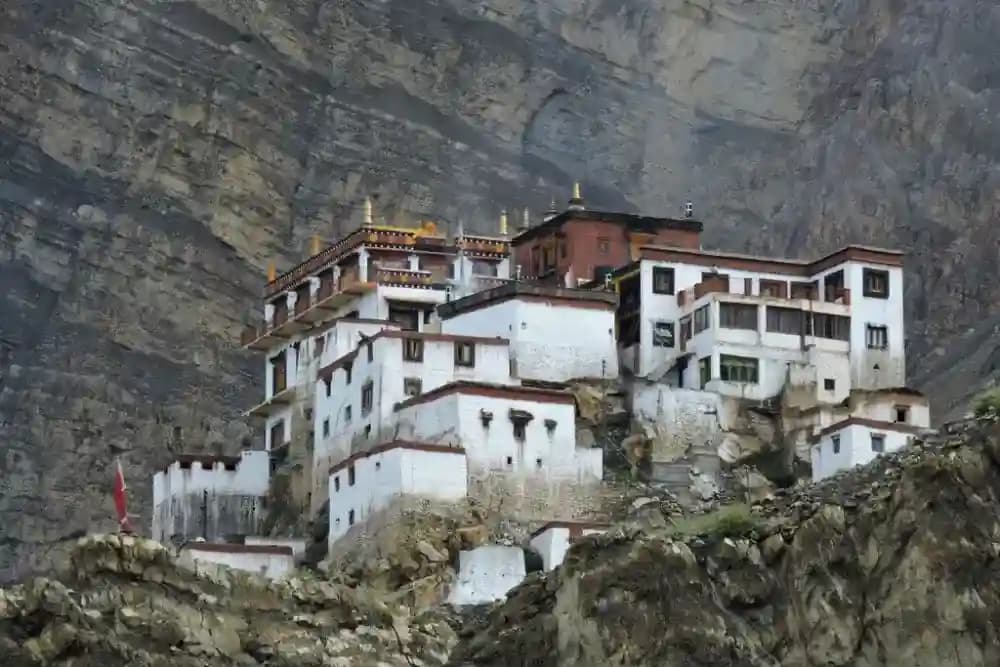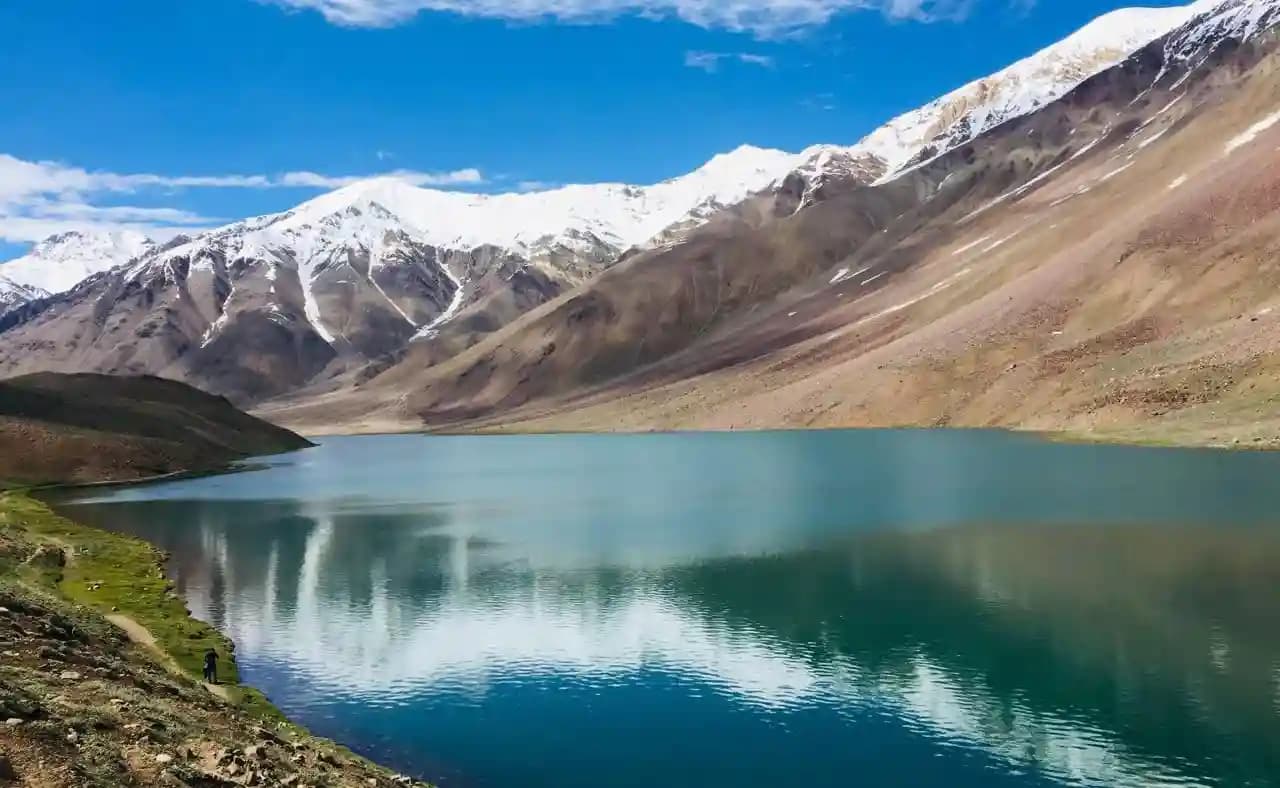Lahaul Spiti is a remote highland valley in Himachal Pradesh, where monasteries have been shaping local life for centuries. These gompas combine art, ritual, and practical learning. The monasteries in Lahaul Spiti range from the oldest to the largest. Tabo Monastery, founded in 996 AD, preserves rare murals and manuscripts. Key Monastery, located at an elevation of approximately 4,166 meters, is the largest in Spiti and serves as an active training centre for monks. Dhankar perches on a cliff above the Spiti and Pin rivers, while Tangyud near Komic stands out for its fortress-like form and high altitude. These are primarily visited by travellers, and this guide highlights ten such monasteries important to visit on the Spiti Valley tour packages, with practical details to help you plan a hassle-free and memorable trip.
10 Best Monasteries in Lahaul Spiti
Monasteries in the Spiti Valley reward all the travellers with living history, peaceful rituals, and scenery that stays with you long after the road ends. These monasteries are living centres of faith, art, and local life. Each one opens a doorway into centuries of devotion, ritual, and mountain survival. Below is an expert-curated list of the top 10 monasteries that you should visit on your trip to the Spiti Valley.
1. Key (Kye) Monastery
Key is the beating heart of Spiti’s monastic life and is one of the best places to visit in Spiti Valley. The hilltop complex evolved through invasions and rebuilds, which gives it a layered, fortress-like plan that photographers love. It is the largest monastery in the Lahaul-Spiti region, and is home to a big community of monks, a library, and a peaceful assembly hall. The official monastery page traces its founding to the early fifteenth century, and places Key monastery at about 13,668 feet above sea level, matching the district records. You can experience live practice, history, and commanding views all in one stop.
Location: Key village, near Kaza, Spiti Valley
Altitude: About 4,166 meters
Best time: May to October
Timings: Open 6:00 AM to 6:00 PM.
2. Tabo Monastery
Tabo is often referred to as the ‘Ajanta of the Himalayas,’ was founded in 996 AD. The old mud-walled temples preserve rare murals, stucco sculptures, and manuscripts. The complex includes nine temples, with one temple having the sacred ‘Wheel of Law’ and decorated stupas. Tabo is the oldest running monastery in Lahaul Spiti and is protected by the Archaeological Survey of India. The Dalai Lama led Kalachakra ceremonies here in 1983 and 1996, which underlines its strong standing foundation. You are walking through a millennium of Himalayan art and learning.
Location: Tabo village, Spiti Valley
Best time: May to October
Timings and entry fee: 6:00 AM to 6:00 PM.
3. Tangyud Monastery
Tangyud feels like a castle in the sky. Built in a fortified style with slanted mud walls and bold vertical stripes, it sits above Kaza on the edge of a deep gorge and within the Kibber Wildlife Sanctuary. Sources regard it as the highest monastery in Lahaul Spiti at almost 4,520 metres, with Sakya tradition and a history that has been traced to the medieval period. The altitude, the architecture, and the view make a powerful combination, and the Sakya ritual life offers a different window on Tibetan Buddhism in Spiti.
Location: Near Komic, Spiti Valley
Best time: June to September
Timings: 6:00 AM to 6:00 PM.
4. Dhankar Monastery
Dhankar clings to a cliff high above the meeting point of the Spiti and Pin rivers. The site served as the traditional capital in the 17th century. The dramatic view of the setting, the history of the Nonos who governed from here, and the quiet surroundings near the statues and thangkas allure every traveller. This monastery in Lahaul Spiti is a perfect example of how monks adapted architectural techniques to withstand the raw geology and harsh climate.
Location: Dhankar village, Spiti Valley
Altitude: Approx. 3,800 meters
Best time: June to September
Timings: 6:00 AM to 6:00 PM.
5. Kungri Monastery
Kungri is the principal Nyingma center in Spiti, and that alone makes it special amongst the Monasteries in Lahaul Spiti. Built around 1330, the monastery consists of three detached east-facing temple blocks, and local tradition keeps alive the sword dance by buzhens from Mud village. If you want to understand the oldest school of Tibetan Buddhism and its ritual arts, this stop must top the list. The valley setting adds quiet charm, and the community remains active through festivals and daily practice. Exploring Kungri along with other gompas is not just a spiritual experience but also one of the most immersive things to do in Spiti Valley, giving travellers a glimpse of ancient rituals, festivals, and the everyday life of monks.
Location: Kungri village, Pin Valley.
Best time: May to October
Timings: 6:00 AM to 6:00 PM.
6. Lhalung Monastery
Lhalung is very engaging and unique. Tradition features the foundation of the Serkhang, also known as the Golden Temple, by Rinchen Zangpo in the late tenth century. The temple's walls are adorned with sculptures of deities. The village setting offers the art a sense of peacefulness, and it feels more ancient and connected to the origins of Spiti's sacred culture. You come here for a peaceful experience with early Himalayan art and the devotional life that has preserved it.
Location: Lhalung village, Spiti Valley
Best time: May to October
Timings: 6:00 AM to 6:00 PM.
7. Shashur Monastery
Shashur means a place among blue pines, and the name matches the setting on a wooded shoulder above Keylong. The monastery was founded by Lama Deva or Dawa Gyatsho in the seventeenth century, linked to the Drukpa tradition that spread from western Himalaya into Bhutan. Visit in June or July, and you may get to witness the Cham festival, with masked dances and large thangka displays. The walk up here is short, the atmosphere is gentle, and the history connects this monastery in Lahaul Spiti to wider Himalayan networks.
Location: Near Keylong, Lahaul.
Altitude: About 600 meters above the valley floor.
Best time: May to October.
Timings: 8:00 AM to 5:00 PM.
8. Tayul Monastery
Tayul is well-known for a massive mani wheel that, according to local legend, rotates on auspicious days and for a magnificent 12-foot statue of Padmasambhava encircled by fierce deities. Sources date back to the foundation in the seventeenth century, and the murals and library add depth for visitors who enjoy iconography. It is an easy outing from Keylong, and the temple interior delivers a powerful, concentrated experience of Himalayan sacred art.
Location: Near Keylong, Lahaul
Best time: May to October
Timings: 6:00 AM to 6:00 PM.
9. Gemur Monastery
Gemur sits above the Bhaga valley on a quiet slope, and many travellers happen to miss it as they rush toward Jispa. This monastery in Lahaul Spiti dates back to the first half of the seventeenth century, and it has long been known for murals and ritual dance traditions. Even when festivals are not running, the complex offers a contemplative stop with views down to the river and fields. The Gemur Monastery, amongst the monasteries in Lahaul Spiti, is a relaxed way to round out a trip to this place.
Location: Gemur village, near Keylong
Best time: May to October
Timings: 6:00 AM to 6:00 PM.
10. Kardang Monastery
Kardang is the most important monastery in Lahaul Spiti, as this village was once the region’s capital. Records note an older foundation, a period of decline, and a full rebuild in 1912. The gompa holds scriptures and images central to Drukpa practice, and it looks across to snow peaks and fields along the Bhaga. If you want one place in Lahaul that pairs regional history with a strong monastic presence amongst the monasteries in Lahaul Spiti, this is it.
Location: Kardang village, near Keylong.
Best time: May to October
Timings: 6:00 AM to 6:00 PM.
Monasteries in Lahaul Spiti are more than mere stops on a travel itinerary. Each one invites you into a world where centuries of devotion, artistry, and resilience still radiate through stone walls and painted halls. Whether you find yourself gazing at the layered fort-like structure of Key or tracing ages-old murals at Tabo, or standing breathless on a cliff-top at Dhankar, you are stepping into all sorts of living heritage. At Tangyud, altitude and architecture combine to mesmerise. In Pin Valley’s Kungri, you meet a different branch of Tibetan Buddhism. These sacred places ask you to slow your pace, listen to chants and wind, and remind you that travel can be as much about inner calm as the outward discovery.
Frequently Asked Questions
1. What are the famous monasteries in Lahaul Spiti?
Spiti is home to some of the most renowned gompas, including Key Monastery, Tabo, Dhankar, Tangyud, Kungri, and Kardang. These gompas are characterised by their ancient murals, cliff-top locations, high-altitude hermitages, and active monastic communities, which have significantly influenced the valley’s culture and history.
2. Which is the largest monastery in Lahaul Spiti?
Kardang Monastery, near Keylong on the Bhaga River, was previously regarded as the largest and most important gompa in Lahaul. However, in the present times, the Key monastery is the largest monastery and also the heart of Spiti’s monastic life in the Spiti Valley.
3. Which is the best monastery in Spiti?
Almost all of the monasteries in Lahaul Spiti are iconic in what they individually offer. Many travellers call Key Monastery the most iconic for its fortress-like silhouette and views. For history and art, Tabo Monastery is often chosen out, founded in 996 and famed for its rare murals and wall art work.
4. Where is Lhalung Monastery located in Lahaul Spiti?
Lhalung Monastery, also called the Serkhang or Golden Temple, sits in Lhalung village in Spiti Valley. The nearby village altitude is about 3,658 metres, and the site is linked to early translations done by Rinchen Zangpo.
5. What is the famous food of Lahaul-Spiti?
Lahaul-Spiti, besides ancient and amazing monasteries, also offers a unique tasting and authentic cuisines. Local favourites include thukpa and thenthuk noodle soups, momos, butter tea, siddu, and madra. Yak and trout dishes also appear where available, reflecting cold climate ingredients and Tibetan-influenced cuisine.








